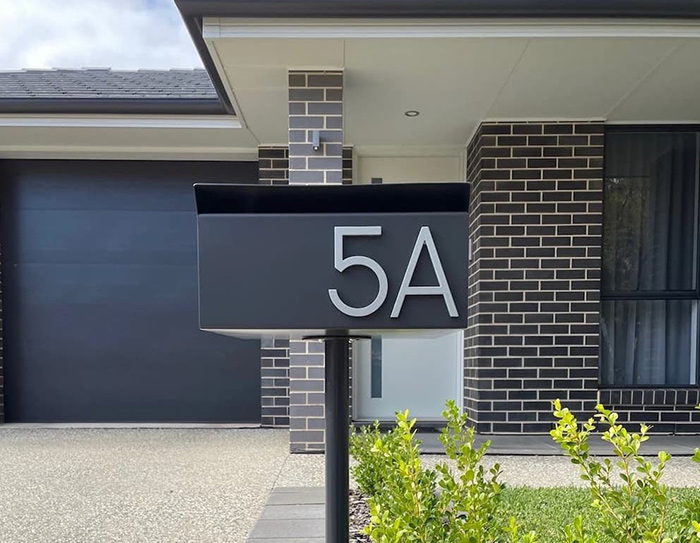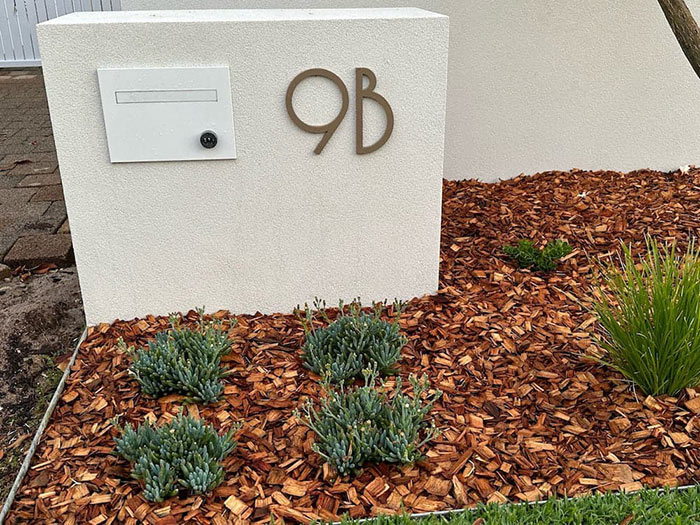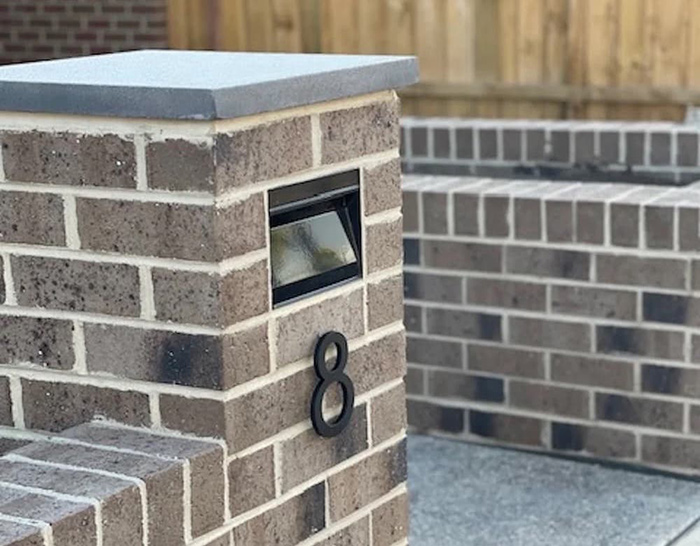What defines a letterbox number?
Letterbox numbers can be viewed as a subset of house numbers, and the terms can often be used interchangeably. Typically, a letterbox number is placed on or very close to the letterbox. Some confusion may arise in the situation where a letterbox may not be a standalone element, but rather it may be integrated into a fence or brick wall. The number next to or close to the letterbox may be referred to as either a ‘letterbox number’ or simply just a ‘house number’!
Selecting the size for your letterbox number
Typically, letterbox numbers tend to be quite small in size. This can be because they are installed on to the letterbox itself, so space may be limited.
We normally recommend a minimum of 100mm height for a letterbox number; anything less than this height can be difficult to see from the street. There’re also some manufacturing challenges with producing very small numbers, and allowing enough thickness in the line weight for a 5mm diameter hole in the rear to install.
When choosing the perfect size for your letterbox number, one key thing to keep in mind is its visibility from the street. You want your guests to spot your house with ease, as after all that's the main reason we have house numbers! If the position of your letterbox places your number close to the street, there's no need to go all out with an extra-large house number. It'll be easily seen without being oversized.
However, if the number is going to be mounted on your home's facade, perhaps a little further from the street, then opting for a larger one could be a good move. This will help ensure it's visible from a distance.
But size isn't the only thing to think about – other factors such as the colour, finish, and font of your number can also play a big role in how easy it is to spot. So, don't forget to consider those when selecting your perfect letterbox number.

Install options for letterbox numbers
House numbers are often installed with a floating mount where a spacer is used to create a small gap between the number and the mounting surface. Letterbox numbers, on the other hand, are usually installed with a flush mount – so there’s no space between the number and mounting surface.
There’re two key ways to achieve a flush mount install:
- Simply install your number in place with the use of some outdoor-rated epoxy adhesive, ensuring you tape the number in the correct location while the adhesive dries.
- The preferred method for installing is to use an installation template, plus rods that fix the back of the number to the exact correct location on your mounting surface.

Step-by-step installation process
To summarise the steps for a flush mount:
- Start by gathering your letterbox numbers, installation template and rods. Also required is a spirit level, tape, epoxy adhesive (we recommend Selleys Araldite), a hammer, drill with a ‘hammer’ setting, and 5mm masonry drill bit.
- Tape the template/s at the desired location on your letterbox. If you have multiple numbers, you may need to overlap to set the spacing. Important: Use a spirit level to ensure the templates are taped on a straight line. Drill holes into your mounting surface according to the marked areas on the template using a 5mm drill bit.
- Apply a small amount of epoxy adhesive to one end of the rods.
- Push the rods into the pre-drilled holes on the back of each number. Light tapping with a hammer may be required. If so, place it on a soft surface to avoid scratching the face of the letterbox number. Wait for the adhesive to dry before proceeding.
- Finally, apply a small amount of epoxy adhesive to the end of the exposed rods and push the number into the drilled holes. Again, light tapping with a hammer may be required. Take care to not scratch the face of the number.

Caring for your letterbox number
Ensuring the visibility and legibility of a letterbox number is essential; however, it doesn't demand significant care or maintenance. Regularly inspect them to confirm they are clearly readable and securely affixed to the letterbox or mounting surface, as they might loosen over time. Maintaining cleanliness by keeping them free of debris aids in increasing their life and ease of locating your house.
For those who live in regions with severe weather conditions such as coastal areas with high salt exposure, additional protective measures might be needed to safeguard the letterbox numbers from environmental elements. Regular wiping of your numbers with a damp cloth with some detergent is normally sufficient. In extreme exposure to salt water, you could consider applying a clear sealant for extra protection.

